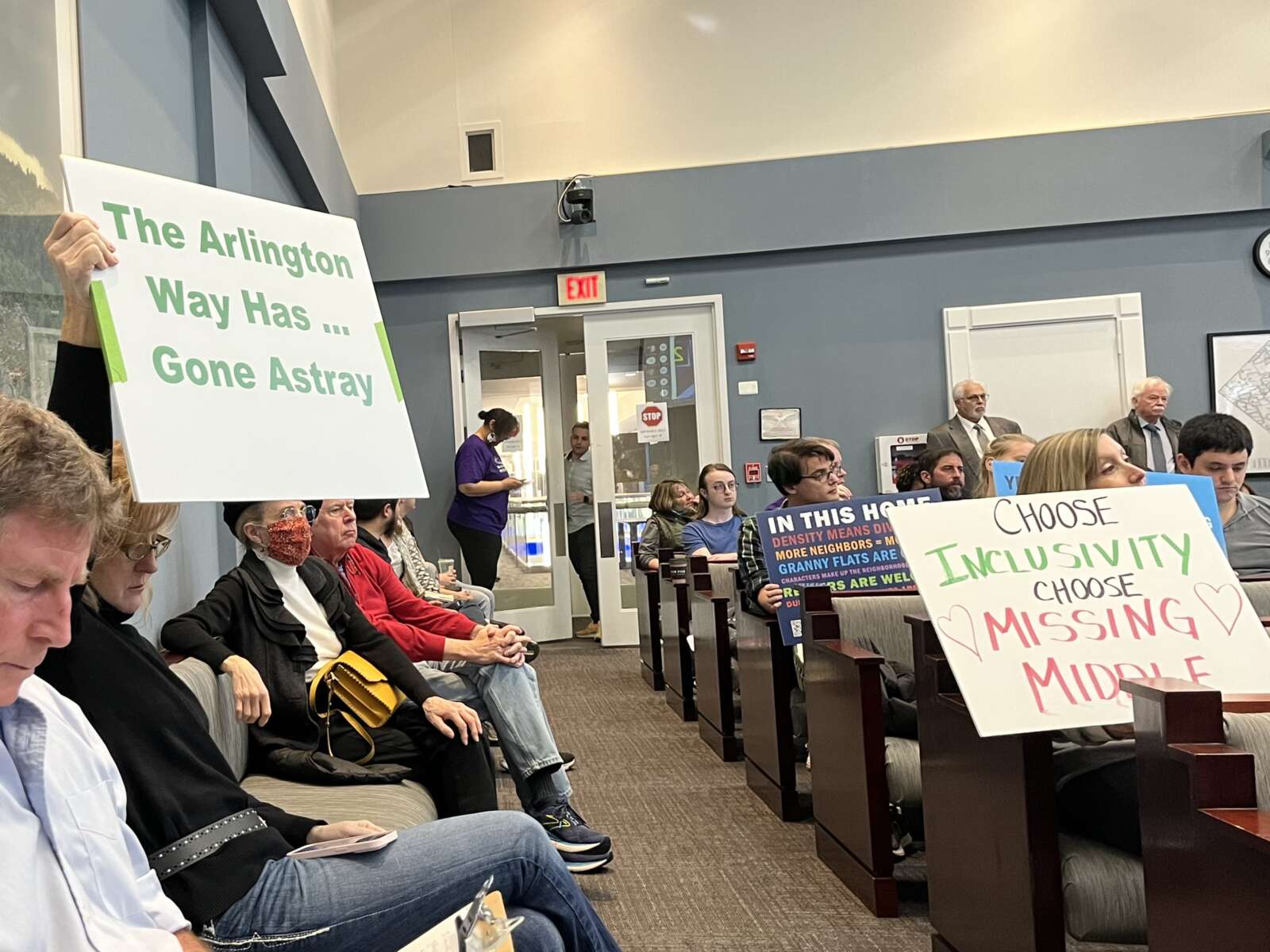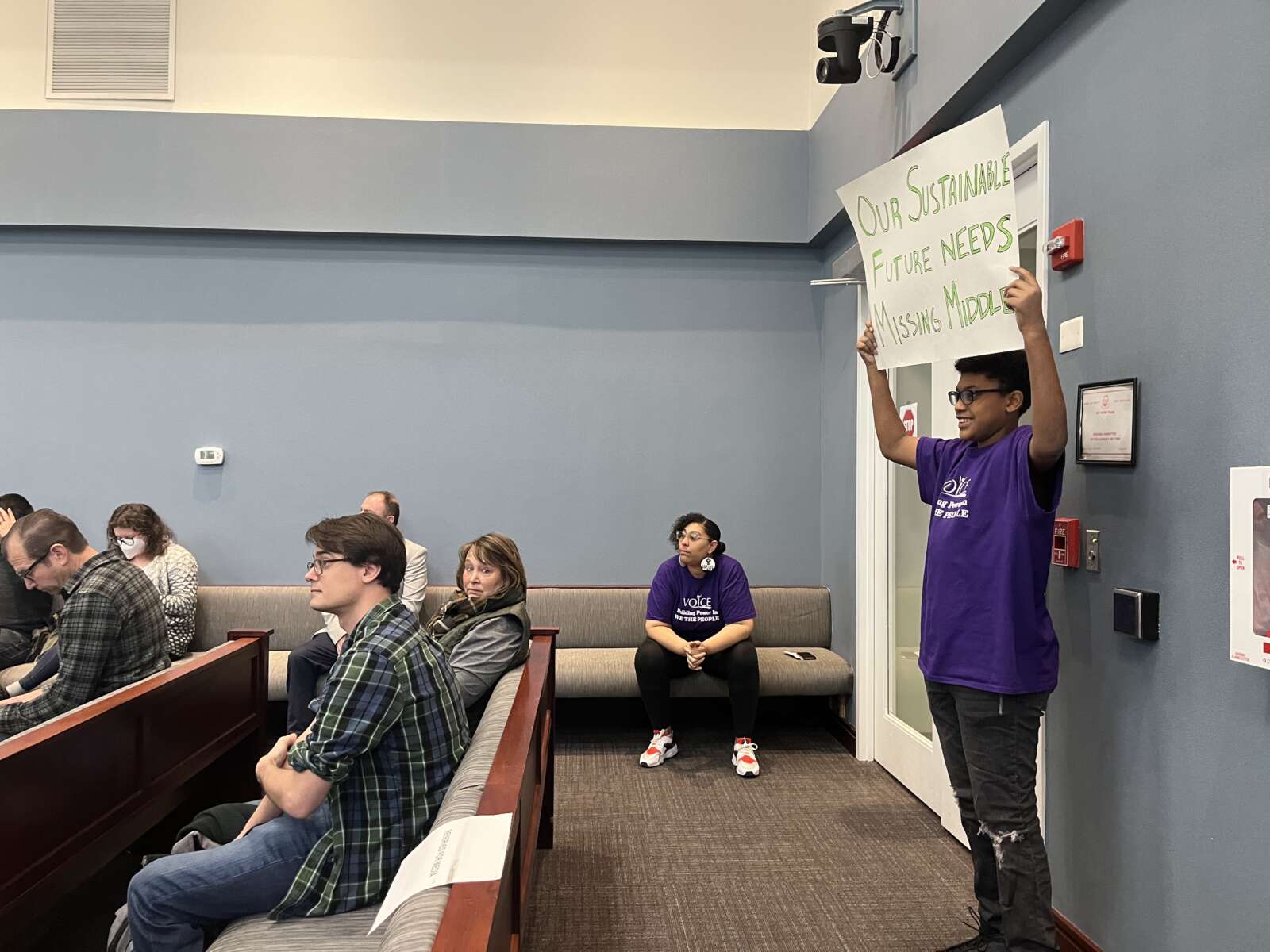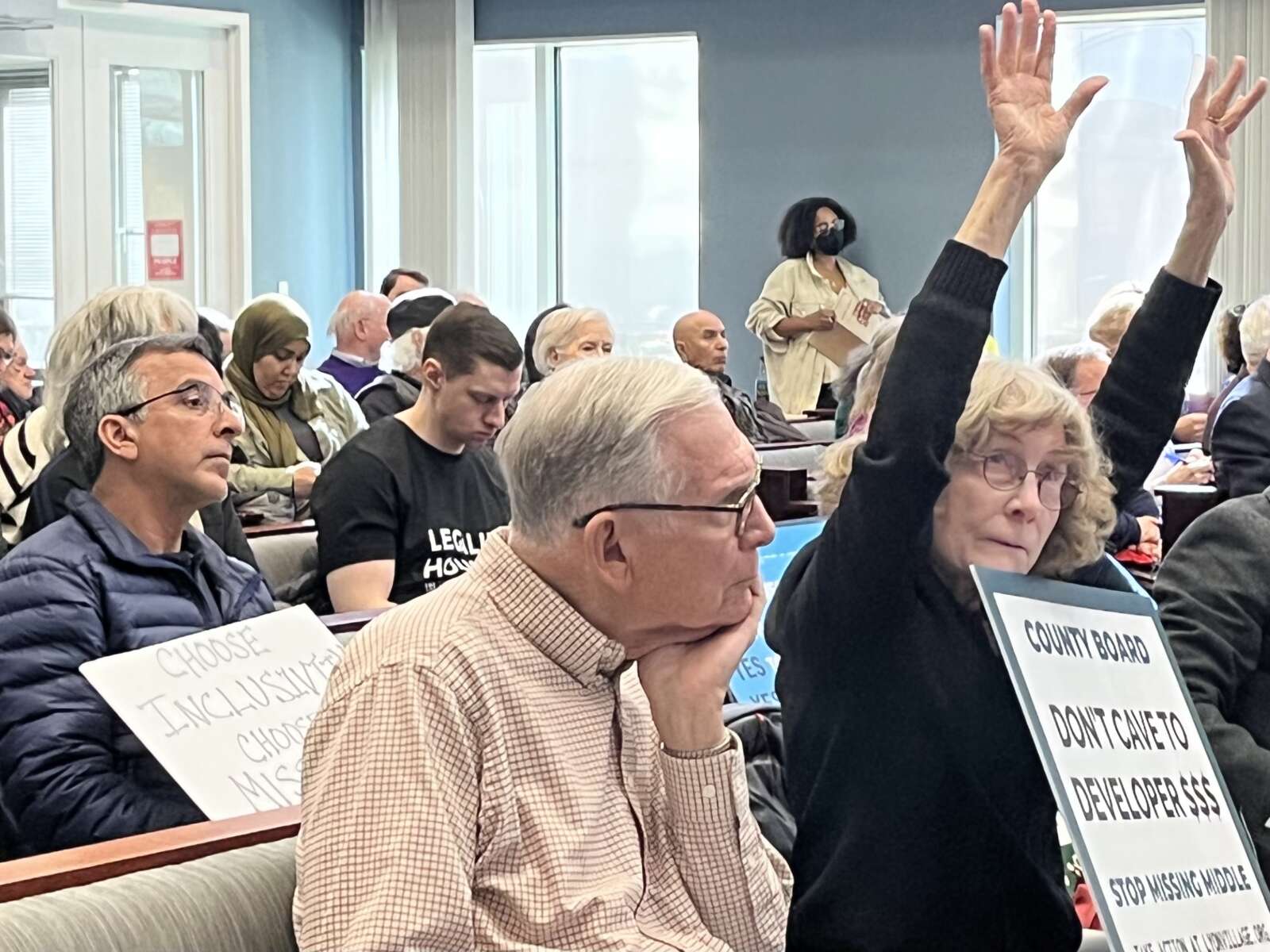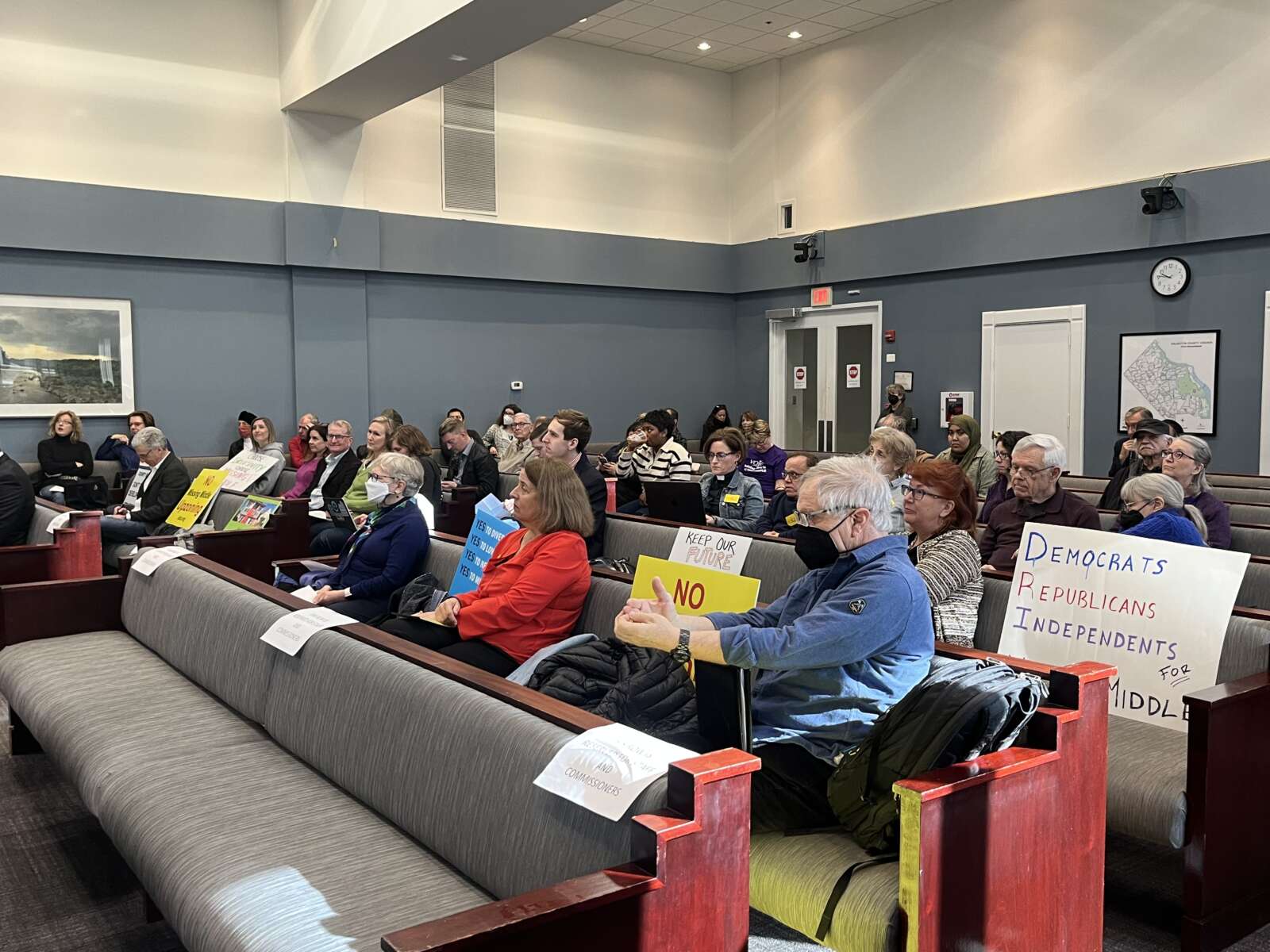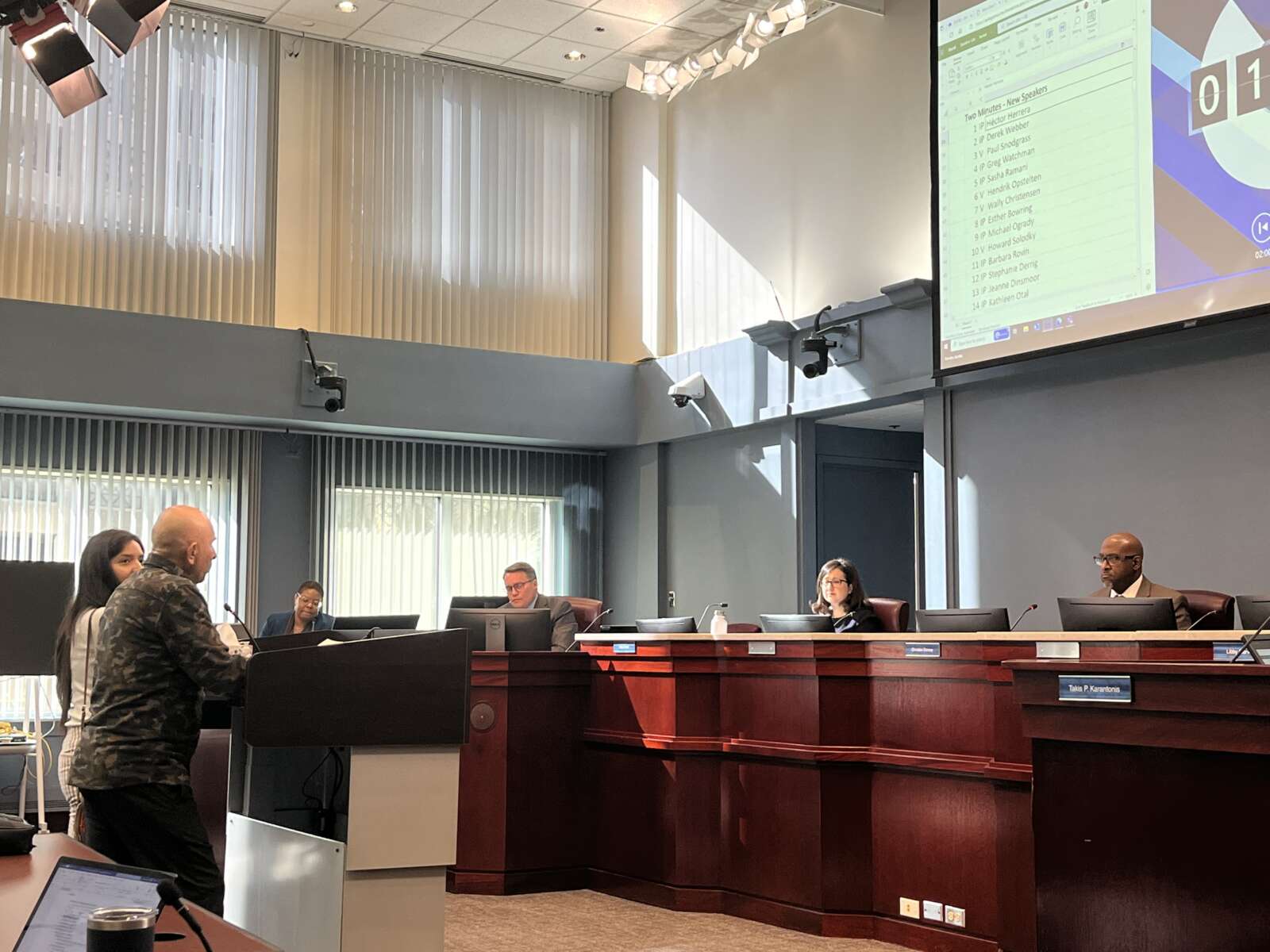Today, Wednesday, could be the day that the Arlington County Board allows the by-right construction of 2-6 unit homes in the county’s lowest density neighborhoods.
The scheduled vote on proposed zoning amendments, known by the shorthand Missing Middle or Expanded Housing Options, would culminate nearly a year of intense discussion since a draft was published in May and updated in November, and before that, more than a year of study and public engagement.
Ahead of the Board’s vote, more than 250 people signed up to urge the Board to move forward with the most expansive options, build more consensus by making a few tweaks, or reject the proposal altogether. The long list of speakers led the County Board to dedicate its regular meeting Saturday and carryover meeting Tuesday to hearing public comment, pushing the vote to today.
On Saturday, about 200 people spoke during the marathon meeting that went from around 8:30 a.m. to just before 6 p.m.
Of the 204 speakers who took the podium on Saturday, some 57% were in favor of the zoning changes, according to a spokesman for YIMBYs of Northern Virginia, an advocacy group supporting the change. At the conclusion of Tuesday night, 226 people had spoken across the two days of hearings, of whom nearly 54% were in favor.
About 50 speakers in support outnumbered about 20 opponents during Planning Commission hearings earlier this month, per commissioner Daniel Weir.
Representatives from the Planning, Transportation and Housing commissions, as well as the Disability Advisory Commission, all voiced strong support for the proposal. By another metric, more than 6,000 people have signed a petition against the proposal as of Tuesday night.
On Saturday, a number of renters and homeowners shared their personal stories of saving — or trying to save– enough money to buy a home in Arlington to underscore the stakes of the changes.
Proponents said more people would have the option to stay in Arlington with Missing Middle housing allowed throughout the county. Opponents disputed how helpful it would be, with some predicting surging property values should the zoning changes be approved. Other opponents predicted the dwellings would deflate property values and jeopardize their long-term investments.
Through an interpreter, Héctor Herrera urged the Board to allow Missing Middle to give Hispanic residents more home-buying opportunities. He and his wife tried twice, unsuccessfully, to buy in 2010 and then in 2016, while working two jobs and even with the help of their adult children.
“Since I came to the U.S. — and I thank God for this wonderful country — I have worked this whole time in the construction industry in Arlington,” Herrera said. “I’ve seen how much it costs to build a house that costs more than $1 million. My community that represents 20% of Arlington cannot buy a house.”
Arlington Presbyterian Church Rev. Ashley Goff said she and her spouse were able to save up enough money while living in an eight-plex in Penrose to buy a townhouse in Shirlington, with help from their parents.
Then, they bought a single-family home on S. Nelson Street in Green Valley, which already has a mix of housing types. She says her family and future generations “greatly benefited” from existing Missing Middle housing.
It’s time to call time of death on Arlington’s exclusionary zoning policy. No need to be gradual or tinker around the edges. Those outside the status quo in Arlington are not to be social experiments with zoning policy. Arlingtonians, particularly Arlingtonians of color, have been waiting for those nearly 100 years for this policy to end and for something new and generous to be created. Please pass the most expansive amendments you can.
John Sellmansberger said he and his spouse also were able to buy a home after years of “scrimping.”
“We sacrificed so our children could have grass to roll in, a tree to climb and a strawberry patch… now a McMansion is being built around the corner and another down the street, probably pushing up values, but values aren’t rising as fast as costs,” he said.
The elderly man described his home as “long-term care insurance” and mused that a six-plex would make this investment less desirable.
“Without guardrails and a serious plan, you’re abdicating the future of Arlington to the developers, and the developers don’t give a hoot about long-term care, or grass, or trees, or strawberry patches,” he said.
While Sellmansberger waxed poetic, one person recited an actual poem. Others were more prosaic.
Stephanie Derrig concluded her speech against the Missing Middle proposal by lambasting the County Board for failing residents.
“Shame on you,” she said. Derrig then handed ARLnow a copy of her speech with a flourish and readdressed the Board from the back of the room, saying “it’s only begun.”
Hazem Alghabra said the “big, blanket upzoning attempt” will not address affordability and critical infrastructure.
“We’ve seen this happen in other cities, especially in California, and what’s resulting is an unusual patchwork of incompatible housing,” he said. “We’re worried about infrastructure, parking and the school system… We are worried this is unplanned and doesn’t resolve the issue at hand of affordable housing in Arlington.”
Daniela Londono, an assistant teacher at Barcroft Elementary School renting in Penrose, urged for less zoning restrictions so she could buy in Arlington.
“I hold a dream, a dream that one day while working as a teacher I can also live in Arlington permanently, and I can keep serving this community that so warmly opened their arms when I arrived to the country as a teenager,” said the native of Colombia.
Old Glebe Civic Association President Howard Solodky tried to strike a middle ground. After conversations with more than a dozen civic associations, he suggested the following changes:
- Capping at 45 permits per year
- Dispersing new EHO units geographically
- Requiring one parking spot per unit
- Limiting the largest buildings to 8,000 square feet
- Allowing, by-right, 2-3 unit buildings on smaller lots and 4-unit buildings on larger lots
A trio of current and former Planning Commissioners had also suggested capping by-right development at four units. They suggested other controls on building size and scale that would apply to both single-family and low-density multi-family homes.
Three of the Arlington County Board candidates vying for the seats of Chair Christian Dorsey and member Katie Cristol also spoke.
Former president of the Arlington branch of the NAACP, Julius (J.D.) Spain, who previously ran for the House of Delegates, supports the most flexible version of the plan.
“The expanded housing option we have before us is smart growth [and] Missing Middle will assist in increasing housing availability across Arlington, and provide housing from various price points, but it is not the answer to all our societal ills,” Spain said. “We need unity, not division, our children are watching. History, history, I remind you, will show who was on the right side of this measure and this moment… Let’s continue to work collaboratively on the next policy issue that is to come to Arlington.”
Both Susan Cunningham, who also previously ran for County Board as an independent, opposes the current plan, as does realtor Natalie Roy . Cunningham led AHC Inc. as interim CEO during the affordable housing provider’s response to reports of poor living conditions at the Serrano Apartments.
If either Roy or Cunningham are elected — they’re running in the Democratic primary in June — that could change the balance on the Board, as Dorsey and Cristol were arguably the most pro-Missing Middle members, outspoken in their disappointment that fellow Board members removed the option to build 7-8 unit buildings.
“Missing Middle, in my view is a mess,” Cunningham said. “The goals have been unclear and shifting, our community is confused, divided, mad, sad, exhausted, and maybe you are, too.”
She suggested instead “a comprehensive approach that adds in long-overdue updates to lot coverage and tree ordinances, property tax relief for those who are aging in place, pilots around homeownership and preservation — especially in our historically African American communities — and investments in truly affordable homes.”
Roy asked the Board a series of rhetorical questions.
“Why are you pushing through a density plan with no clear goals or guardrails? Why are you pushing for something that is the antithesis of affordability and diversity? Why are you advocating for a plan that is a gift to developers?” she asked. “How can you in good faith ram this density package through when you have such a divided community? What do you know that we don’t?”
In comments at the start of the Saturday meeting, Dorsey addressed the recent resolution from Arlington County Civic Federation intended to improve public confidence in governance, which, among other criticisms, says the Missing Middle process lacked transparency.
(The Civic Federation’s approval of the resolution prompted the Arlington NAACP to leave the organization, having unsuccessfully suggested a more toned-down version.)
Dorsey said he welcomed conversations with those who want to engage in improving public engagement in “good faith.”
But, he said, “we also know that there are people who use public engagement and public confidence in governance as a way to provide a euphemism for their utter disappointment with decisions that are made.”
Dorsey called on the Civic Federation to work collaboratively with county officials to suggest improvements to community engagement efforts, rather than simply being a venue for people “to air their grievances over decisions they don’t like.”


